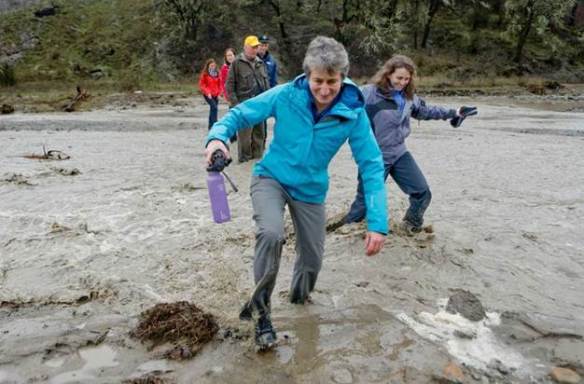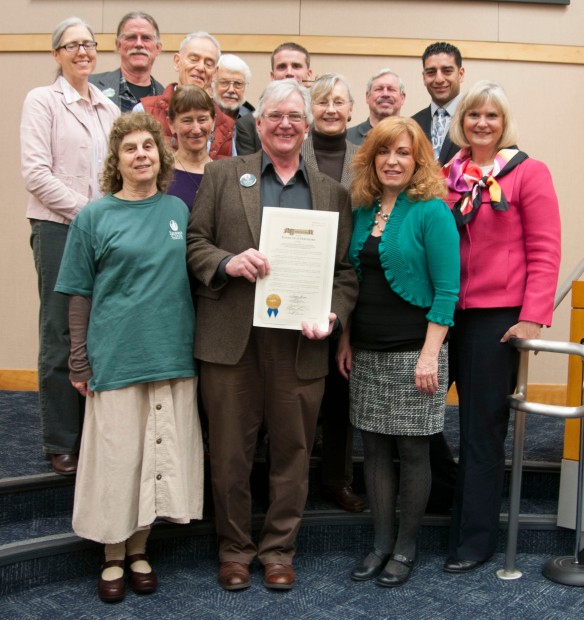
Secretary Sally Jewell likes to see — and touch! — things for herself. Before the forum Congressman Thompson escorted her and Undersecretary Bonnie on a hike on the Redbud Trail into the Cache Creek Wilderness, where they forded Perkins Creek and — as Secretary Jewell reported during the meeting — saw a herd of tule elk and unmistakable evidence of recent mountain lion presence. photo courtesy San Francisco Chronicle
by Victoria Brandon, Redwood Chapter Chair
On Friday December 19 Secretary of the Interior Sally Jewell and Undersecretary of Agriculture Robert Bonnie joined Congressman Mike Thompson, Congressman John Garamendi, and other community leaders in a Town Hall meeting at the Napa Community College to gather public input on the proposal for the permanent protection of the 350,000-acre Berryessa Snow Mountain region as a National Monument.
Legislation introduced by Representative Thompson and Senator Barbara Boxer to designate the area as a National Conservation Area appears to be hopelessly stalled in Congress, but President Obama can use his powers under the Antiquities Act to reach the same goal by creating a national monument, sidestepping congressional deadlock.
As was abundantly illustrated by the expert local panel assembled for the Napa event, the region is characterized by outstanding conservation values and a wealth of recreational opportunities. Just a short drive from both the San Francisco Bay and Sacramento metropolitan areas and stretching 100 miles from south of Lake Berryessa to north of Snow Mountain, it contains three federal Wilderness areas and a Wild & Scenic River. Black bear, tule elk, river otters, and bald eagles live there, as do such an extraordinary variety of native plants that it qualifies as a biodiversity hotspot of global importance. Hikers, hunters, kayakers, anglers, birdwatchers, equestrians, waterskiers, mountain bikers, hang gliders, and off-road enthusiasts all have a vested interest in its permanent preservation.
An economic report recently released by the Winters Chamber of Commerce indicates that special designation is also likely to result in increased tourism, providing economic benefits to surrounding communities estimated at $50 million over five years. The new monument will also be eligible for increased funding as part of the National Landscape Conservation System, and the federal agencies that manage it — the US Forest Service, Bureau of Land Management, and Bureau of Reclamation — will have the tools they need to work collaboratively.
Even though the Town Hall meeting took place on a rainy Friday less than a week before Christmas and with only a few days advance notice, a near-capacity crowd was in attendance, with the vast majority expressing support for permanent protection as either an NCA or a national monument. Not surprisingly, the Sierra Club was out in force, with a delegation that included national Deputy Director Bruce Hamilton, Sierra Club California Director Kathryn Phillips, Mother Lode Chapter Chair Barb Williams and national Wilderness chair Vicky Hoover among many others. Several of us were fortunate enough to have our cards drawn for a chance to speak at the meeting.
What next? First, let’s thank our visitors from Washington for making the time in their busy schedules to see this special place with their own eyes and to hear our voices: please take a moment to visit berryessasnowmountain.org to add your name to a card of appreciation. Second, let’s make sure the president knows about our support for national monument designation: that’s easy to do from the Redwood Chapter home page, redwood.sierraclub.org. Third, stay tuned for an exciting announcement! When the president decides to act, we’ll make sure you find out right away.




